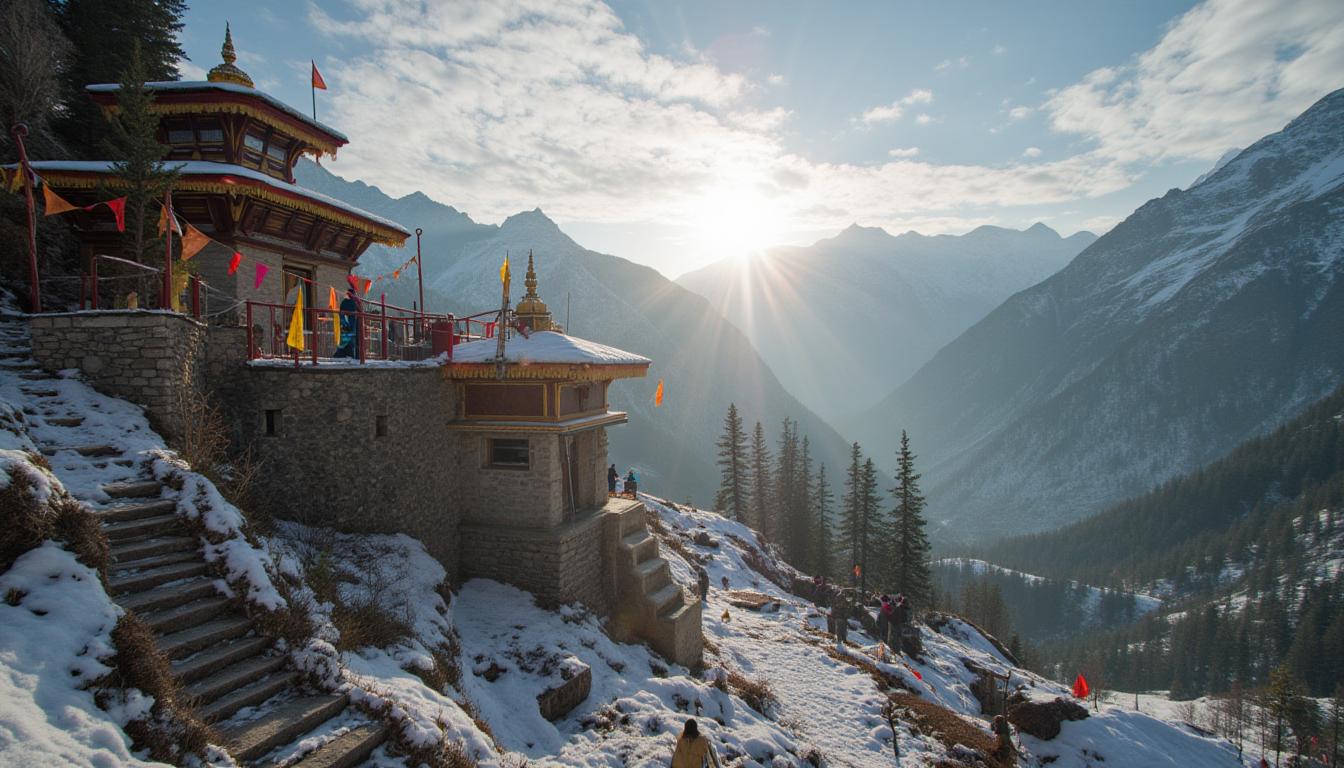Himachal Pradesh, often referred to as the “Land of Gods,” is not just famous for its scenic mountains and lush valleys but also for its rich cultural and religious heritage. Among its spiritual treasures, Shakti Peethas in Himachal Pradesh hold a special place, attracting devotees, history enthusiasts, and architecture lovers alike. These sacred temples are revered not only for their spiritual significance but also for their stunning architectural designs that reflect centuries of devotion, craftsmanship, and local culture.
In this blog, we will explore some of the most iconic Shakti Peethas in Himachal Pradesh, understand their architectural beauty, historical importance, and why they continue to mesmerize visitors even today. Whether you are planning a spiritual journey or a heritage tour, these temples are bound to leave you awestruck.
Understanding Shakti Peethas
Shakti Peethas are sacred shrines dedicated to Goddess Shakti or Sati, the consort of Lord Shiva. According to Hindu mythology, when Sati immolated herself in protest of her father Daksha’s insult to Lord Shiva, Shiva, in his grief and rage, carried her body across the universe. Wherever parts of her body fell, temples were established to honor her. These sites became powerful centers of Shakti worship, symbolizing feminine divine energy and spiritual power.
Himachal Pradesh, with its mountains, rivers, and secluded landscapes, became an ideal place for the establishment of several Shakti Peethas. Each temple showcases unique architectural features, often blending local Himalayan styles with traditional Hindu temple designs.
Architectural Styles of Shakti Peethas in Himachal Pradesh
The architecture of Shakti Peethas in Himachal Pradesh is an amalgamation of local Himalayan craftsmanship and the traditional Hindu temple architecture. The temples often reflect the following features:
1. Stone and Wood Craftsmanship: Many temples are constructed using locally sourced stone and deodar wood. Intricate carvings on wooden pillars, doorways, and ceilings demonstrate the skilled artistry of Himachali craftsmen.
2. Pagoda-style Roofs: Influenced by Tibetan and local hill architecture, several Shakti Peethas feature multi-tiered pagoda roofs, which not only add grandeur but also help withstand heavy snowfall.
3. Mandapas and Garbhagriha: The sanctum sanctorum or Garbhagriha is usually simple but sacred, housing the idol of the Goddess. Mandapas or pillared halls in front often display detailed carvings, murals, and religious symbols.
4. Courtyards and Steps: Due to the hilly terrain, many temples are built with elevated platforms and steps leading up to the shrine. Courtyards serve as gathering areas for devotees during festivals and rituals.
5. Stone Sculptures and Frescoes: Detailed sculptures of deities, guardians, and mythological scenes often adorn temple walls, providing a glimpse into the region’s artistic and religious history.
Top Shakti Peethas in Himachal Pradesh
Himachal Pradesh is home to several important Shakti Peethas, each with its own unique charm and architectural style.
1. Jwalaji Temple, Kangra
One of the most famous Shakti Peethas in Himachal Pradesh, the Jwalaji Temple in Kangra, is renowned for its eternal flame that burns from a natural gas source, symbolizing the divine energy of Goddess Jwalamukhi.
Architectural Highlights:
The temple’s architecture is a blend of traditional Nagara style with local hill designs. It features a sanctum housing the goddess’s flame, intricately carved wooden doors, and a large courtyard where devotees gather during festivals like Navratri. The temple’s stone walls and pillars reflect ancient craftsmanship, and the surrounding hills add to its spiritual aura.
Spiritual Significance:
The temple is believed to be where the tongue of Sati fell. Devotees from across India visit to seek blessings, especially during Navratri, when the temple sees thousands of pilgrims.
2. Chamunda Devi Temple, Kangra
Perched atop a hill near Dharamshala, the Chamunda Devi Temple is dedicated to Goddess Chamunda, a fierce form of Shakti. It offers panoramic views of the surrounding valleys and mountains.
Architectural Highlights:
The temple is constructed using stone and features a simple yet elegant design. Its sloping roof, characteristic of hill architecture, protects against snow and rain. Inside, the sanctum houses the idol of Chamunda, adorned with traditional Himachali ornaments. The approach to the temple includes winding steps and a pathway lined with prayer flags, enhancing the spiritual journey.
Spiritual Significance:
Devotees believe that worshipping at Chamunda Devi Temple brings courage, protection, and prosperity. The temple is especially popular during the festival of Navratri.
3. Naina Devi Temple, Bilaspur
Naina Devi Temple, situated on a hilltop overlooking the Gobind Sagar Lake, is one of the most revered Shakti Peethas in Himachal Pradesh. The temple is dedicated to Goddess Naina Devi, whose eyes are said to have fallen at this spot.
Architectural Highlights:
The temple features a stone façade and a wooden sanctum. It is built in the traditional Himalayan style with sloping roofs and intricately carved balconies. The temple complex includes courtyards and steps leading up to the shrine, allowing devotees to circumambulate the sacred space. The surrounding lake and forested hills amplify the temple’s serene atmosphere.
Spiritual Significance:
Pilgrims visit the temple to seek protection, blessings, and spiritual guidance. The annual Navratri fairs attract thousands of devotees, making it a lively spiritual hub.
4. Chintpurni Temple, Una District
Chintpurni Temple is another prominent Shakti Peetha in Himachal Pradesh. It is dedicated to Goddess Chinnamastika, symbolizing self-sacrifice and spiritual power. The temple’s location amidst the Shivalik hills adds to its mystical charm.
Architectural Highlights:
The temple’s architecture combines traditional Himachali elements with simple stone and wood structures. The main sanctum houses the deity, while the exterior features detailed carvings and a small pagoda-style roof. Courtyards and staircases enhance accessibility, and the temple complex is surrounded by scenic forested hills.
Spiritual Significance:
The temple is believed to fulfill the wishes of devoted visitors. Festivals like Navratri see large gatherings of devotees who perform rituals and offer prayers to the goddess.
5. Brajeshwari Devi Temple, Kangra Valley
Brajeshwari Devi Temple is known for its unique architectural style and its serene hilltop location. The temple is dedicated to Goddess Brajeshwari, a powerful form of Shakti worshipped for protection and prosperity.
Architectural Highlights:
The temple is primarily built using stone and wood, with detailed carvings depicting mythological stories. The roof design follows the traditional hill temple style, and the entrance is adorned with sculpted motifs. The inner sanctum houses the deity, and the surrounding courtyard allows devotees to gather and perform rituals.
Spiritual Significance:
The temple is a popular pilgrimage site, attracting devotees during major Hindu festivals. Worshipping here is believed to bring blessings, health, and spiritual well-being.
Festivals and Cultural Significance
Shakti Peethas in Himachal Pradesh are not only architectural marvels but also cultural epicenters. Festivals such as Navratri, Diwali, and local fairs are celebrated with grandeur at these temples. Devotees perform rituals, offer flowers, light lamps, and participate in processions.
The temples also host traditional music and dance performances, providing a glimpse into Himachal Pradesh’s rich cultural heritage. These festivals are an opportunity to witness the vibrant local art forms, rituals, and the devotion of pilgrims, making each visit a truly immersive experience.
Visiting Tips for Shakti Peethas in Himachal Pradesh
Planning a visit to these temples requires some practical considerations to ensure a fulfilling experience:
- Best Time to Visit: September to June is ideal, avoiding heavy monsoon rains. Festivals like Navratri are especially vibrant.
- Travel and Accessibility: Most temples are accessible by road. Some hilltop temples require trekking, so wear comfortable footwear.
- Accommodation: Nearby towns and hill stations offer a range of accommodation options, from budget stays to luxury resorts.
- Local Cuisine: Don’t miss local Himachali delicacies in nearby towns and dhabas.
- Respect Religious Practices: Maintain decorum, follow temple guidelines, and dress modestly when visiting these sacred sites.
Adotrip provides curated travel experiences, making it easier for visitors to explore Shakti Peethas in Himachal Pradesh while enjoying comfortable travel and guided tours.
The Architectural Legacy of Shakti Peethas
The architectural styles of these temples reflect the ingenuity and spiritual devotion of past generations. The combination of stone, wood, and metal work, along with intricate carvings and frescoes, tells stories of mythological significance and local traditions.
These temples are more than just places of worship; they are living museums preserving centuries-old craftsmanship, religious practices, and cultural identity. The fusion of art, spirituality, and nature in these sites creates an unparalleled experience for visitors.
Why Explore Shakti Peethas with Adotrip
Planning a journey to multiple Shakti Peethas can be overwhelming due to the rugged terrain and scattered locations. Adotrip offers comprehensive tour packages that include transportation, accommodation, guided tours, and cultural experiences. By choosing Adotrip, travelers can:
- Explore the spiritual and architectural beauty of each temple without hassle.
- Learn about the history, legends, and significance from experienced guides.
- Experience local culture, cuisine, and festivals along the way.
Whether you are a pilgrim, a history enthusiast, or an architecture lover, Adotrip ensures a safe, comfortable, and enriching journey through Himachal Pradesh’s sacred sites.
Conclusion
Himachal Pradesh’s Shakti Peethas are a perfect blend of spiritual energy, architectural brilliance, and natural beauty. Temples like Jwalaji, Chamunda Devi, Naina Devi, Chintpurni, and Brajeshwari Devi showcase the region’s rich religious traditions, artistic heritage, and the devotion of generations of pilgrims.
Exploring these temples is not just a spiritual journey; it is a chance to witness architectural marvels carved with precision, preserved over centuries, and enveloped by the serene Himalayan landscape. For anyone seeking a combination of faith, history, and breathtaking scenery, visiting Shakti Peethas in Himachal Pradesh with Adotrip promises an unforgettable experience.
Embark on this journey to discover the divine energy, architectural splendor, and cultural richness that make these Shakti Peethas timeless treasures of Himachal Pradesh.
Frequently Asked Questions (FAQ)
1. What are Shakti Peethas in Himachal Pradesh?
Shakti Peethas in Himachal Pradesh are sacred Hindu temples dedicated to Goddess Shakti or Sati. According to mythology, these are the sites where parts of Sati’s body fell when Lord Shiva carried her across the universe. These temples are revered for their spiritual power and architectural beauty.
2. Which is the most famous Shakti Peetha in Himachal Pradesh?
The Jwalaji Temple in Kangra is one of the most famous Shakti Peethas in Himachal Pradesh. It is renowned for its eternal flame, symbolizing the divine energy of Goddess Jwalamukhi. Other notable temples include Chamunda Devi, Naina Devi, Chintpurni, and Brajeshwari Devi.
3. What is unique about the architecture of these temples?
Shakti Peethas in Himachal Pradesh feature a blend of traditional Hindu temple architecture and local Himalayan styles. They are often made of stone and wood, with pagoda-style roofs, intricately carved pillars, courtyards, and frescoes depicting mythological stories.
4. When is the best time to visit Shakti Peethas in Himachal Pradesh?
The ideal time to visit these temples is from September to June, avoiding heavy monsoon rains. Festivals like Navratri are especially vibrant and provide a unique experience of devotion and cultural celebrations.
5. Are these temples accessible for tourists?
Yes, most Shakti Peethas in Himachal Pradesh are accessible by road. Some hilltop temples require climbing steps or light trekking, so comfortable footwear is recommended. Guided tours with Adotrip make visiting these sites easier and more convenient.
6. What are the major festivals celebrated at these temples?
Navratri is the most significant festival celebrated at Shakti Peethas. Devotees also visit during Diwali and local fairs. During these festivals, the temples host rituals, music, dance, and cultural performances.
7. Can I combine a pilgrimage to multiple Shakti Peethas in one trip?
Yes, with proper planning, you can visit multiple Shakti Peethas. Adotrip offers curated tour packages that cover major temples like Jwalaji, Naina Devi, Chintpurni, Chamunda Devi, and Brajeshwari Devi, ensuring a hassle-free spiritual journey.
8. Do these temples have any historical significance apart from religious beliefs?
Yes, besides their spiritual importance, Shakti Peethas in Himachal Pradesh are historical treasures. They showcase centuries-old craftsmanship, traditional Himalayan architecture, and cultural heritage, preserving local art, sculptures, and frescoes.
9. Are there accommodation options near these temples?
Yes, nearby towns and hill stations offer various accommodation options ranging from budget stays to luxury resorts. Booking through Adotrip ensures comfortable lodging along with guided tours to these sacred sites.
10. Why should I explore Shakti Peethas with Adotrip?
Exploring with Adotrip provides a well-organized experience, covering transportation, accommodation, and guided tours. Visitors also get insights into temple history, local culture, festivals, and architectural highlights, making the journey more enriching and enjoyable.







